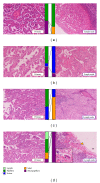Prognostic implication of predominant histologic subtypes of lymph node metastases in surgically resected lung adenocarcinoma
- PMID: 25371901
- PMCID: PMC4209754
- DOI: 10.1155/2014/645681
Prognostic implication of predominant histologic subtypes of lymph node metastases in surgically resected lung adenocarcinoma
Abstract
The International Association for the Study of Lung Cancer, American Thoracic Society, and European Respiratory Society (IASLC/ATS/ERS) proposed a new classification for lung adenocarcinoma (AD) based on predominant histologic subtypes, such as lepidic, papillary, acinar, solid, and micropapillary; this system reportedly reflects well outcomes of patients with surgically resected lung AD. However, the prognostic implication of predominant histologic subtypes in lymph nodes metastases is unclear so far. In this study, we compared predominant subtypes between primary lung tumors and lymph node metastatic lesions in 24 patients with surgically treated lung adenocarcinoma with lymph node metastases. Additionally, we analyzed prognostic implications of these predominant histologic subtypes. We observed several discordance patterns between predominant subtypes in primary lung tumors and lymph node metastases. Concordance rates were 22%, 64%, and 100%, respectively, in papillary-, acinar-, and solid-predominant primary lung tumors. We observed that the predominant subtype in the primary lung tumor (HR 12.7, P = 0.037), but not that in lymph node metastases (HR 0.18, P = 0.13), determines outcomes in patients with surgically resected lung AD with lymph node metastases.
Figures



References
-
- Siegel R, Ward E, Brawley O, Jemal A. Cancer statistics, 2011: the impact of eliminating socioeconomic and racial disparities on premature cancer deaths. CA Cancer Journal for Clinicians. 2011;61(4):212–236. - PubMed
-
- Travis WD, Brambilla E, Muller-Hermelink HK, et al. World Health Organization Classification of Tumors. Lyon, France: IARC Press; 2004. Pathology and genetics: tumors of the lung, pleura, thymus and heart. - PubMed
-
- Motoi N, Szoke J, Riely GJ, et al. Lung adenocarcinoma: modification of the 2004 WHO mixed subtype to include the major histologic subtype suggests correlations between papillary and micropapillary adenocarcinoma subtypes, EGFR mutations and gene expression analysis. The American Journal of Surgical Pathology. 2008;32(6):810–827. - PubMed
-
- Warth A, Muley T, Meister M, et al. The novel histologic International Association for the Study of Lung Cancer/American Thoracic Society/European Respiratory Society classification system of lung adenocarcinoma is a stage-independent predictor of survival. Journal of Clinical Oncology. 2012;30(13):1438–1446. - PubMed
Publication types
MeSH terms
LinkOut - more resources
Full Text Sources
Other Literature Sources
Medical

